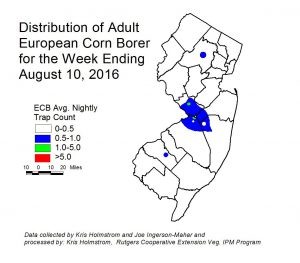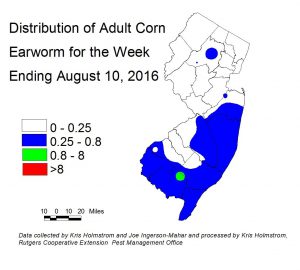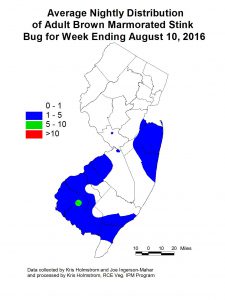Sweet Corn
 European corn borer (ECB) adult activity continues to be very low. Areas of highest activity have shifted to the central counties, and particularly Mercer County (see ECB map). As always, consider treating when the number of infested plants in a 50 plant sample exceeds 12%. Any planting remaining at or above threshold as it proceeds to full tassel should be treated, as this is the last stage at which ECB larvae will be exposed and vulnerable to insecticidal sprays. See the 2016 Commercial Vegetable Recommendations Guide for insecticide choices.
European corn borer (ECB) adult activity continues to be very low. Areas of highest activity have shifted to the central counties, and particularly Mercer County (see ECB map). As always, consider treating when the number of infested plants in a 50 plant sample exceeds 12%. Any planting remaining at or above threshold as it proceeds to full tassel should be treated, as this is the last stage at which ECB larvae will be exposed and vulnerable to insecticidal sprays. See the 2016 Commercial Vegetable Recommendations Guide for insecticide choices.
The highest nightly ECB catches for the previous week are as follows:
| Crosswicks 2 | Denville 1 |
| Lawrenceville 2 | Downer 1 |
| Allentown 1 | Eldora 1 |
| Beckett 1 | Georgetown 1 |
Fall armyworm (FAW) infestations continue throughout NJ, with infestation rates ranging above 50% in southern and central counties. Lower numbers have been found in the north, but FAW is present in all counties at this time. This pest can be devastating to small corn plants. Fields down to seedling stage should be scouted weekly for signs of infestation. Treat when FAW alone or in combination with ECB damage exceeds 12% plants infested. FAW do not respond well to pyrethroid insecticides. The most useful products are those in the IRAC group 28 class (Coragen, Exirel, Belt) or the IRAC group 5 class (Radiant, Entrust), or combination products including these classes. See the 2016 Commercial Vegetable Recommendations Guide for insecticides effective against FAW.
 Corn earworm moth (CEW) activity has declined somewhat over the past week. The majority of moths have been caught in the southern third of the state, with a few consistent catches in the central coastal areas. Blacklight traps further north in the state have registered only scattered individuals (see CEW map). Overall activity is quite low for this time of year. Catches in DE are similar to those in southern NJ, and trap catches published from North Carolina are variable, with some now declining. All this points to gradual increase rather than a major influx. More consistent catches should become the norm over the next several weeks.
Corn earworm moth (CEW) activity has declined somewhat over the past week. The majority of moths have been caught in the southern third of the state, with a few consistent catches in the central coastal areas. Blacklight traps further north in the state have registered only scattered individuals (see CEW map). Overall activity is quite low for this time of year. Catches in DE are similar to those in southern NJ, and trap catches published from North Carolina are variable, with some now declining. All this points to gradual increase rather than a major influx. More consistent catches should become the norm over the next several weeks.
The highest nightly CEW catches for the previous week are as follows:
| Centerton 1 | Eldora 1 | Medford 1 |
| Crosswicks 1 | Farmingdale 1 | Old Bridge 1 |
| Denville 1 | Green Creek 1 | Pedricktown 1 |
| East Vineland 1 | Jones Island 1 | Woodstown 1 |
The limited CEW pheromone trap network in the southern counties also decreased somewhat over the past week. Activity has shifted so that it is highest in central areas of southern NJ (see CEW pheromone map). The low number of traps results in broad areas of color within the map. It is critical that growers monitor local CEW moth numbers. At present, this population constitutes a moderate threat to silking corn.
The highest nightly CEW pheromone trap catches for the previous week are as follows:
| Elm 17 | Monroeville 9 | East Vinelaned 4 |
| Woodstown 17 | Pedricktown 9 | Beckett 3 |
| Jobstown 10 | Green Creek 7 |
For silking sweet corn, the following spray schedules are warranted.
Silking Spray Schedules*:
South – 3-4 days
Central – 4 days
North – 5-6 days
*These recommendations are based on regional catches.
Brown Marmorated Stinkbug (BMSB)
 BMSB numbers declined in southern NJ blacklight traps this past week. The highest activity remains along the Delaware Bay Shore. BMSB are being captured in all parts of the state, although in much reduced umbers in the north. It is important that host crops like peppers be scouted regularly for the presence of BMSB and other stinkbugs at this time.
BMSB numbers declined in southern NJ blacklight traps this past week. The highest activity remains along the Delaware Bay Shore. BMSB are being captured in all parts of the state, although in much reduced umbers in the north. It is important that host crops like peppers be scouted regularly for the presence of BMSB and other stinkbugs at this time.
The highest nightly BMSB trap catches for the previous week are as follows:
| Centerton 9 | Pedricktown 4 | Medford 3 |
| Woodstown 5 | Springdale 4 | Cinnaminson 2 |
| Eldora 4 | Beckett 3 | Georgetown 2 |
| Farmingdale 4 | Crosswicks 3 | Matawan 2 |
Pumpkins and Winter Squash
Powdery mildew (PM) is active on pumpkin and winter squash fields throughout NJ. The action threshold for commencement of the protectant fungicide program for PM is 2 lesions per 100 older leaves. See the 2016 Commercial Vegetable Recommendations Guide for a list of appropriate protectant fungicide rotations for PM control.
Downy mildew (DM) is present on cucumbers in all parts of NJ. All growers should be applying appropriate protectant fungicides plus DM specific materials to cucumbers at this time. DM lesions appear as yellow areas on the upper leaf surface with leaf veins making distinct borders to the lesions. On the lower leaf surface, beneath the lesions, dark spores may be seen if conditions are moist. For more information on the regional presence of DM as well as comprehensive, weekly forecasts, see the following website: http://cdm.ipmpipe.org/ . At this time, NJ is at low risk for further spore deposition and infection, according to the Cucurbit Downy Mildew Forecast. All reported infections in our region to date are on cucumber.
Peppers and Tomatoes
Stinkbugs continue to be found in scouted fields with increasing frequency over the past week. These bugs are laying eggs now. As eggs hatch, nymphs ( which cannot fly) will remain clustered together, causing significant local injury to green and ripening fruit. If fruit injury is increasing in harvests, or stinkbug adults, nymphs, or eggmasses are found in more than one of 10 samples in a field, consider treating for this pest to limit injury. See the 2016 Commercial Vegetable Recommendations Guide for insecticides effective against stinkbugs.
Pepper weevil
None have been trapped in the past week at either farms or processing facilities. As far as known, there are no infested fields. After mid-September,
infestations will be of little concern.


